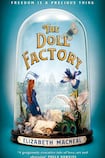
In September 1853, the artist Dante Gabriel Rossetti drew a picture of his favourite model and muse Elizabeth Siddal. There was nothing unusual about this - over the course of their tumultuous relationship, Rossetti would produce thousands of images of the pale, red-haired woman who later became his wife. But the Lizzie Siddal in this inky sketch is very different from the languid, heavy-lidded girl who gazes away from the viewer in galleries around the world. This drawing shows her hunched over a drawing board, pen in hand, looking intensely at her subject – Rossetti himself – as she sketches. The muse has become the artist, fizzing with energy; the man who famously immortalised the faces of the beautiful “stunners” he painted has become a subject himself.
I thought about this wonderful drawing a lot when reading Elizabeth Macneal’s debut novel The Doll Factory, a book that manages to be both a page-turning thriller and a thoughtful, moving exploration of what it meant to be a woman and an artist in the 19th century. Set in 1850 and 1851, it’s the story of Iris Whittle, a red-haired young woman from a painfully respectable London family. At the start of the book, Iris is working at a Regent Street doll shop, where she spends her days painting features onto china faces. At night she sneaks down to the cellar where, having managed to save up enough money to buy paper and paints, she works on her own art.
When Iris is approached by Louis Frost, an artist desperately in need of a model, she agrees on one condition: that Louis teach her how to paint. And so a partnership is born, in which Iris, like Siddal, becomes both the muse and the student of a member of the pre-Raphaelite Brotherhood. But while Iris revels in her new creative life with Louis, someone is watching her: a taxidermist called Silas Reed, who has been obsessed with Iris after briefly meeting her at the future site of the Great Exhibition in Hyde Park, where he hopes to display some of his preserved animals and butterflies.
What could have been a stereotype instead becomes a deeply moving portrayal of life at the bottom
Perfectly paced and richly atmospheric, The Doll Factory is an incredibly assured debut novel. Writing about visual art isn’t always easy to do well, but Macneal writes about her real and fictional artists and their work so evocatively that the reader not only sees the vivid colours in their palettes, but understands their importance to the pre-Raphaelites. The generous, good natured Frost is, of course, fictional, but Macneal deftly inserts him into the heart of the PRB; he has friendly arguments with Holman Hunt, shares Rossetti’s affection for pet wombats and, like Millais, becomes the object of Dickens’s critical ire.
As the months go by, Iris becomes not just Louis’s model but his creative collaborator, as well as an artist in her own right. And yet when the painting of her is displayed, she realises that she has literally become objectified by its male viewers. The painting’s gilded frame has become both a crown and a cage. But Iris has her own distinct, original artistic vision, and throughout the novel Macneal explores, with sensitivity and insight, how a woman can develop that vision and be truly seen as an individual in a world where her opportunities are curtailed.
Macneal is not only interested in the limitations placed on would-be artists; one of the novel’s most sympathetic characters is Albie, a cheeky street urchin living with his prostitute sister. What could have been a sub-Dickensian stereotype instead becomes a deeply moving portrayal of life at the bottom of Victorian London, a brave boy who “hates [his life] in sudden, unexamined flashes, though he accepts it too, and does not think of his life in terms of happiness or unhappiness, just as survival.”
Even Silas is a horribly convincing depiction of disappointment, bitterness and entitlement. His plans for Iris may be predictable to anyone who’s read John Fowles’s novel about another isolated young man who collects dead butterflies, but that doesn’t make The Doll Factory any less compelling; I literally couldn’t put it down for the final breathtakingly tense 70 pages. The Doll Factory is emotionally and intellectually engaging with an utterly gripping plot. In a word that the pre-Raphaelites would appreciate, it’s a stunner.










